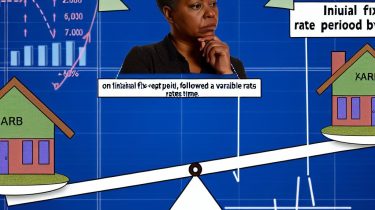How adjustable-rate mortgages (ARMs) function.

Understanding Adjustable-Rate Mortgages (ARMs)
Adjustable-rate mortgages, often abbreviated as ARMs, represent a type of home loan product that fundamentally differs from fixed-rate mortgages. While fixed-rate mortgages maintain a constant interest rate throughout the entire loan term, ARMs have interest rates that vary based on changes in an associated financial index. This characteristic presents both opportunities and risks for borrowers, making it crucial to understand the details of how they work.
Key Characteristics of ARMs
ARMs typically begin with a lower interest rate than fixed-rate mortgages, which can be appealing to individuals seeking initial cost savings on their home loan payments. This feature provides financial flexibility during the early years of homeownership. However, it must be noted that after a predefined period, the interest rate will adjust periodically based on market conditions.
Initial Rate Period
The introductory phase of an ARM is labeled the initial rate period. During this time, the borrower enjoys a fixed interest rate that usually stands lower than rates offered on fixed-rate mortgages. This period can vary, spanning from as short as one month to as long as ten years, contingent on the mortgage’s specific terms. Essentially, this phase allows homeowners to benefit from lower initial payments, potentially facilitating significant upfront savings.
Adjustment Period
Upon conclusion of the initial period, the ARM transitions into the adjustment period. In this stage, the interest rate is subject to change, influenced by fluctuations in the financial index it is tied to. Indices commonly involved include the London Interbank Offered Rate (LIBOR), the Cost of Funds Index (COFI), and the Constant Maturity Treasury (CMT) rate. These indices reflect broader financial market trends and will affect how your interest rate is adjusted over time. For a comprehensive understanding of these indices, explore resources like this article.
Rate Caps and Limits
ARMs are generally equipped with specific caps that limit the degree to which both the interest rate and the monthly payments can change. These limitations serve to safeguard the borrower from drastic financial fluctuations, ensuring some level of predictability:
Periodic Rate Cap: This cap restricts the amount by which the interest rate can increase from one adjustment period to the next, providing a degree of stability in the borrower’s monthly financial obligations.
Lifetime Rate Cap: This cap sets the maximum interest rate that can be charged over the life of the loan, providing assurance that the rate will not surpass a certain level, regardless of index fluctuations.
Payment Cap: Meanwhile, a payment cap limits how much the monthly payment can increase during an adjustment period. However, it is important to note that not all ARMs feature a payment cap.
These caps collectively work to provide peace of mind for the borrower, offering protection against extreme variations in payments and securing a buffer against sharp market shifts.
Potential Advantages of ARMs
One significant advantage of ARMs is the lower initial interest rate, which can considerably reduce mortgage payments in the early years. This feature can be particularly beneficial for those who are anticipating an increase in income or are planning to refinance or sell the property before the initial rate period ends. Another advantage arises when market interest rates decline; borrowers can then enjoy lower mortgage payments during adjustment periods, potentially experiencing further financial relief.
Potential Risks and Considerations
Despite their benefits, ARMs carry inherent risks, primarily due to the uncertainty in future payment amounts. Should the index associated with the ARM rise considerably, the borrower may face elevated payments. Such situations necessitate careful assessment of one’s financial stability and capacity to manage potential increases in payments. Prospective borrowers must thoroughly evaluate whether they possess the financial flexibility and risk tolerance to accommodate these fluctuations in payments.
Financial Planning for ARMs
In contemplating an ARM, effective financial planning plays a vital role. Prospective borrowers should ensure that they understand their current financial status and future financial goals. This understanding will aid in evaluating whether the potential advantages of an ARM align with personal financial objectives and risk appetite. Consulting with financial advisors or mortgage professionals can help clarify these considerations.
Concluding Thoughts
Adjustable-rate mortgages can serve as a powerful tool for certain borrowers, especially those seeking to minimize short-term living costs. For individuals planning for specific life events, such as transferring employment locations or upgrading their living arrangements within a defined time frame, ARMs can provide flexibility and initial affordability. Despite their potential benefits, meticulous consideration of long-term financial plans and personal risk tolerance is essential. Borrowers should seek guidance and resources from financial planning experts or reputable mortgage lenders to make informed decisions best suited to their individual circumstances.
This article was last updated on: January 13, 2025